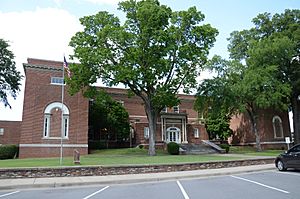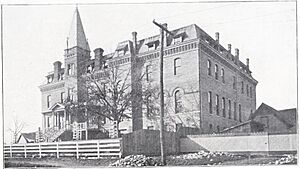Philander Smith College facts for kids
 |
|
| Type | Private, HBCU |
|---|---|
| Established | 1877: Walden Seminary 1882: Philander Smith College |
|
Religious affiliation
|
United Methodist Church |
|
Academic affiliations
|
UNCF |
| Endowment | $3 million |
| President | Roderick L. Smothers |
| Students | 760 |
| Location |
,
U.S.
|
| Colors | Green and gold |
|
Sporting affiliations
|
NAIA |
Philander Smith College is a private college located in Little Rock, Arkansas. It is a historically black college, which means it was founded to provide education for Black students. The college is connected to the United Methodist Church. It also helped create the United Negro College Fund (UNCF), an organization that supports students attending historically black colleges. Philander Smith College is officially recognized by the North Central Association of Colleges and Schools.
Contents
Discover Philander Smith College History
Philander Smith College first opened in 1877. It was called Walden Seminary back then. The goal was to offer education to formerly enslaved people living west of the Mississippi River. In 1882, the school changed its name to Philander Smith College. This was to honor Adeline Smith, who gave money to the school. She was the wife of Philander Smith.
The school became a four-year college in 1883. It gave out its first bachelor's degree in 1888. In 1933, it joined with George R. Smith College. That college had burned down in 1925. By 1943, Philander Smith was officially recognized by the North Central Association of Colleges and Schools.
During the Civil Rights Movement, students at Philander Smith College were very active. They used peaceful protests, like sitting at "whites-only" lunch counters. This helped fight against segregation laws.
Explore the Campus
|
Philander Smith College Historic District
|
|
| Location | Roughly bounded by 13th, 11th, Izard, and State Sts., Little Rock, Arkansas |
|---|---|
| Area | less than one acre |
| Architect | Almand, John Parks |
| Architectural style | Colonial Revival, Bungalow/Craftsman, et al |
| NRHP reference No. | 99000229 |
| Added to NRHP | September 13, 1999 |
The college campus is in the middle of Little Rock. A highway, Interstate 630, runs just north of the campus. The campus is bordered by 10th and 14th streets to the north and south. Gaines and Chester streets are to the east and west.
The main part of the campus was first built for Little Rock Junior College. A two-block area of the campus is listed on the National Register of Historic Places. A key building is the Cox Administration Building. It used to be the U.M. Rose School. A famous architect, John Parks Almand, designed it in 1915.
The campus also has the "Old Gym." This gymnasium was built by the WPA during the Great Depression. Another building is a former barracks from Camp Robinson Air Force Base. It was moved to the campus in 1948.
Philander Smith College Athletics
The sports teams at Philander Smith College are called the Panthers. The college is part of the National Association of Intercollegiate Athletics (NAIA). Since 2011, they mostly compete in the Gulf Coast Athletic Conference (GCAC). Before that, they were an independent team in the NAIA.
Philander Smith offers 10 different sports. For men, there's basketball, cross country, and track & field. Women's sports include basketball, cross country, track & field, and volleyball. Cheerleading is a sport for both men and women.
Athletic Achievements
The men's basketball team made history in the 2012–13 season. They won their first GCAC conference tournament title.
On February 21, 1989, the women's basketball team had a big win. They beat Rust College 92–89 on their home court. This ended the longest home-court winning streak in NCAA Division III women's basketball history.
Famous People Who Attended Philander Smith
| Name | Class year | Notability | |
|---|---|---|---|
| "Geese" Ausbie | a former player and coach for the Harlem Globetrotters | ||
| Al Bell | founder of Stax Records and former president of Motown Records | ||
| Isaac M. Burgan | President of Paul Quinn College from 1883–1891 and 1911–1914 | ||
| James Hal Cone | 1958 | a major thinker in systematic theology and liberation theology | |
| L. Clifford Davis | 1945 | a civil rights lawyer and judge | |
| Joycelyn Elders | 1952 | a former Surgeon General of the United States | |
| Stephanie Flowers | Arkansas State Senator since 2011 | ||
| Scipio Africanus Jones | coursework before transfer to Shorter College | a lawyer and businessman | |
| Calvin King | 1975 | a farm developer and president of the Arkansas Land and Farm Development Corp | |
| Amina Claudine Myers | a musician | ||
| Elijah Pitts | 1961 | a former player for the Green Bay Packers | |
| Lottie Shackelford | a former mayor of Little Rock, Arkansas | ||
| Robert L. Williams | 1953 | a well-known figure in African-American psychology | |
| Deon Cole | a comedian |
- Devon Scott (born 1994), a basketball player in the Israel Basketball Premier League
Notable Faculty Members
| Name | Department | Notability | Reference |
|---|---|---|---|
| Lee Lorch | a mathematician and civil rights activist | ||
| Georg Iggers | a historian | 10 |


